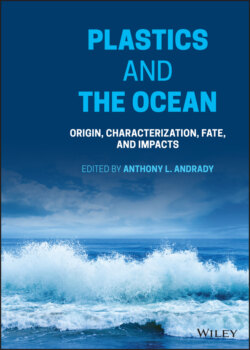Читать книгу Plastics and the Ocean - Группа авторов - Страница 32
1.7.2 Plastics in Building
ОглавлениеAs with packaging, only a handful of different plastics are used in building construction; these, along with the percentage of global production used in building, are PVC (69%), HDPE (20%), PUR (29%) and PS (28%). The percentages shown are for that of the global production in 2015 (Geyer et al. 2017). Some LDPE and PP are also used in building, but to a lesser extent of only about 6% of their respective production volumes.
The most‐used resin type in building construction is PVC, both as (i) rigid unplasticized compounds, uPVC, in cladding (siding), window frames, water pipes/fittings, pipes, and rainwater goods; and (ii) plasticized, flexible compounds, pPVC, in laminates as membrane roofing, flooring tiles, and cable sheaths. PVC pipes are widely used in water transport because of their low cost and convenience in installation using quick connections compared to competing water pipes. Some chlorinaed PVC (or CPVC) is also used, especially in hot‐water applications, because of its relatively higher softening temperature compared to PVC. Plastic window or door profiles, also made of uPVC, are widely used because of their ease of installation and relatively low lifetime costs. Flooring made of PVC in laminate or engineered flooring, the most‐used flooring in the US, is also popular in Asia, Australia and some parts of Europe (Pickard and Sharp 2020). HDPE, competes with PVC as a material for pipe applications but has a relatively shorter service life, but is the plastic of choice in constructing storage tanks for water.
Table 1.9 gives a comparison of the environmental characteristics of several different pipe materials for the distribution of potable water. The savings in embodied energy (EE) on using lower‐density, lower melting, non‐corrosive, and easy‐to‐assemble PVC, in place of conventional ductile iron, concrete, or clay pipes is easy to appreciate (Uni‐Bell 2017).
Another important application is the use of plastic foam insulation in building and refrigeration, that exploits their low density as well as their very low thermal conductivity. The closed cells in polyurethane foam contain inert gases that are very good thermal insulators. Until recently, the inert gas used as a blowing agent for PU foam was Freon (especially, trichlorofluoromethane), but after these were identified as ozone‐depleting chemicals, pentanes were substituted in their place. The thermal conductivity of PU foam depends on the cell size and generally varies between 0.02 and 0.03 W/m K, at atmospheric pressure. PU foam is used in applications such as refrigeration and cold storage as well as in insulation.
Table 1.9 Embodied energy and carbon data for 8‐inch diameter water pipes.
Source: Calculated from Du et al. (2013).
| Iron‐concrete lined (DICL) | PVC | Concrete (reinforced) | Cast Iron | HDPE | |
|---|---|---|---|---|---|
| Embodied Energy (MJ/100‐ft) × 103 | 33.94 | 19.18 | 9.53 | 25.5 | 23.79 |
| Embodied Carbon (MTCO2‐e/100 ft) | 14.4 | 9.69 | 2.08 | 10.76 | 218 |
| Weight (Lbs/ft) | 22 | 5.619 | 60 | 34 | 6.65 |
| Expected pipe burst (50 years) | 1 | 1 | 18 | 3 |
